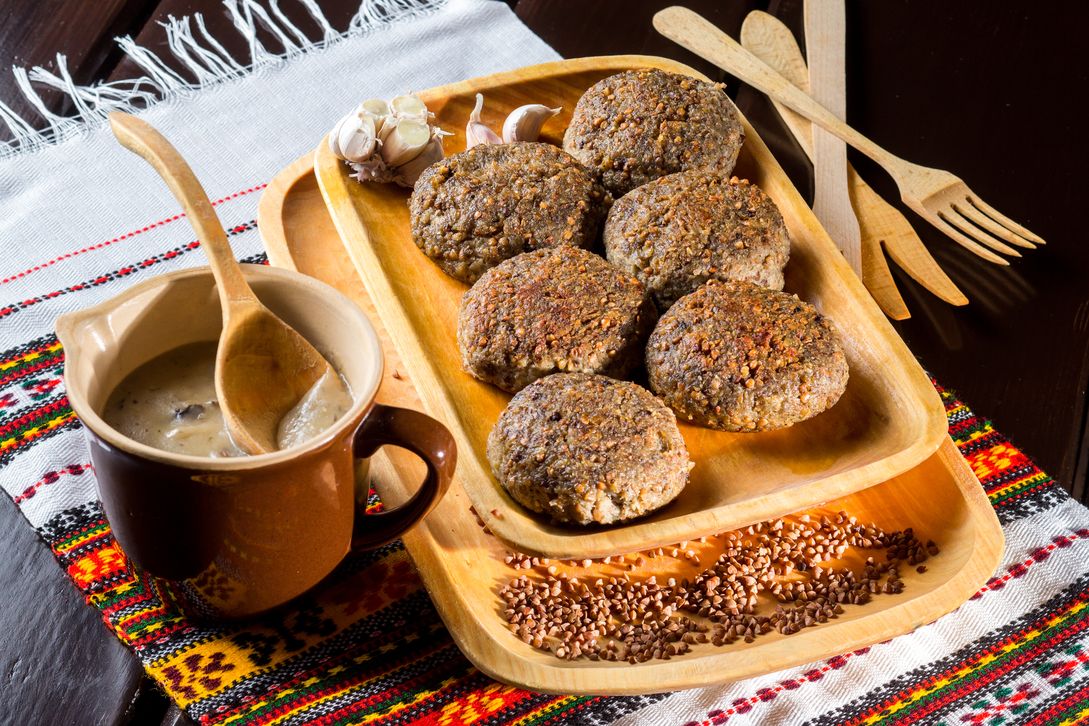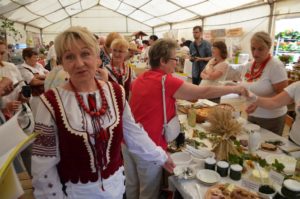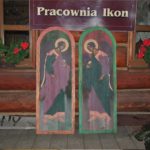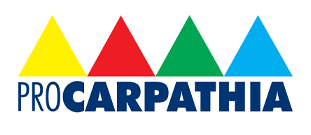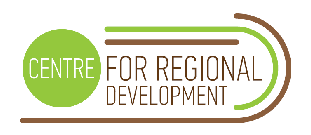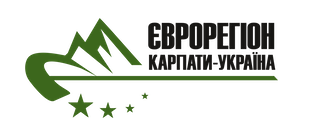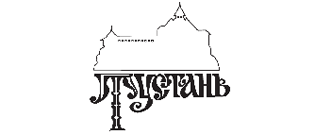The legend of the Bieszczady and Low Beskid, as an area full of wild, uncontaminated nature as well as an area with a complicated history of the 20th century – has become a lure for millions of tourists visiting this part of Podkarpackie Voivodeship. Although these lands have changed fundamentally in the last two decades: there is already a good road network, a varied accommodation base for every budget and interesting catering facilities, this legend is still present in the public awareness.
Fortunately, the old mosaic of nations and ethnos of the Polish-Slovak and Polish-Ukrainian border area is not a completely closed card. The history of the past has changed the population relations of the region and there is no longer a scale of Boyko or Lemko element. However, the legacy of these nations survived, the tradition of dishes and products prepared by the Ruthenian highlanders, who lived on this borderland, has remained. These are simple, cheap, nutritious dishes. They were the result of tradition, the availability of products, the richness of pantry space at different seasons, the geographical location and the predominant livestock farming in the region.This part of the Polish Carpathians is an area that did not spoil its inhabitants with abundance of products. Not the best soil and harsh mountain climate caused that hunger often prevailed under the thatch of cottages, especially during the hungry gap. Food was often sought in the forest and meadows, hence the menu of Lemkos and Boykos included mushrooms (pickled hats of red pine mushroom and honey fungi), hazelnuts and blueberries, and even nettle, sorrel, blueberry or goosefoot, thanks to which it was possible to survive the most difficult periods. During the poor harvest, to save money, birch bark or oak bark, graminis rhizoma, acorns were added to baking flour.
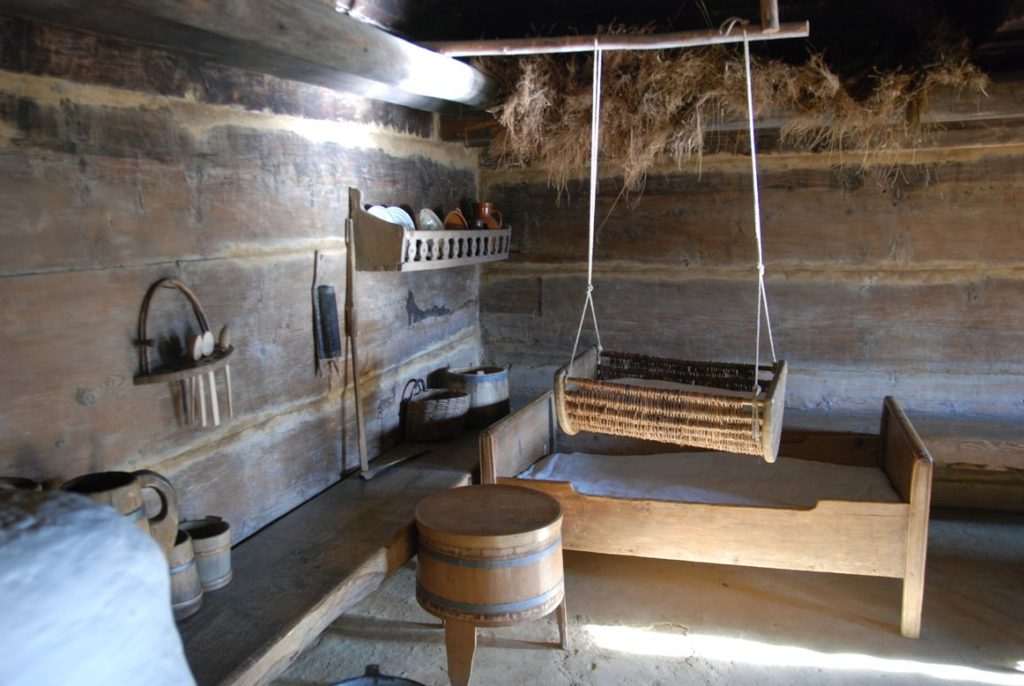
The interior of the Lemko cottage from Komańcza, currently in the exhibition of the Museum of Folk Architecture in Sanok.
The basic raw materials used for food production were cow’s, goat’s and sheep’s milk. It was used to make cottages, butter, buttermilk, whey or żentyca (drink made from sheep milk). People used to eat a little meat, they usually ate it during major festivals and weddings. Podpłomyki and proziaki – a kind of pancakes based on sourdough, beer sourdough or without sourdough were baked using a kitchen tiled stove. An important element of the diet were potatoes, which were used in various ways. So-called cyr was popular – grated potatoes were formed into small dumplings, which were then thrown into boiling water. The rest of the old potatoes were thrown into the boiling water in the pot. The whole was served with milk or greaves. Łewesz, a kind of potato soup, was cooked with cumin or peas and beans. Lemko bandurjanki are simple potato pancakes, baked in a bread oven, on fresh cabbage or maple leaves. Also in the oven, stolniki were baked – grated potato dumplings with potato stuffing with fried onions. Earlier, borderland cuisine was dominated by various groats, pearl barley was obtained from barley, and millet. Barley were combined with e.g. beans or dried plums, and a pearl barley with whey, sour cabbage or milk, when preparing popular pancakes. Lentils, broad beans or peas were often used. Corn-flour and milk based pastry has appeared on the table. Linseed oil, hempseed oil as well as pork fat were commonly used as a liquid fat.
Gifts from the forest, meadows, home garden and orchard were an important part of the menu. In winter, sauerkraut (stewed with caraway seed, cooked with peas or beans) and pickled cucumbers were at the top, and soups were cooked based on sauerkraut juice, e.g. hasty pudding called sour soup (kwasówka). Borscht and oat sour rye soup (kysełycia) eaten with potatoes were often cooked. Soups with goosefoot, sorrel and nettle were also prepared. Peas, cabbage, turnips, onions, beets, carrots, parsley, broad beans and beans were eaten. Mushrooms and fruit were also dried for the winter.
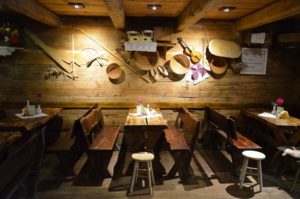
The building of Gospoda Pod Białą Górą is a former granary that is at the entrance to the Museum of Folk Architecture in Sanok.
Podkarpackie region is famous for its meals with very original names, behind which there are quite simple dishes derived from the cuisine of Ruthenian highlanders: hreczanyki (buckwheat groats chops mixed with ground meat, eggs, garlic and spices), knysze (dumplings fried in deep fat with buckwheat groat, cottage cheese and onion stuffing), kugel (a cake made of grated potatoes, stuffed with sauerkraut stuffing stewed with onion and greaves). There are also other dishes, like for example: krężałki, hałuszki, małdrzyki, szabanka and krupniak. These old specialties can be found in local restaurants and pubs, they sometimes may be ordered at agritourism farms located in the south.
However, the best place to taste these dishes is the “Agrobieszczady” Craft and Entrepreneurship Fair in Lesko, that are regularly organised in July each year by the Podkarpackie Voivodeship Local Government, the largest event of its kind in the region, during which the farmers’ wives association often offer such delicacies.
Boykos’ food
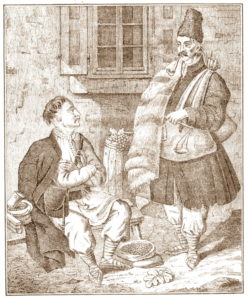 Agricultural crops imposed on the Boykos a diet in which the basic role was played by potatoes, cabbage as well as grain, processed into groats and flour. There were rarely dairy products, because the strict fasts prohibited the consumption of dairy products, butter, milk or cheese.Meat was also eaten once in a blue moon. They ate three times a day, and in winter they sometimes two times a day. Breakfast was called obid, it was eaten at 9.00 a.m., usually one dish, e.g. beetroot borscht, sweet milk, sour milk, cooked broad bean, oat flour soup (czyr), a mix of barley, rye and sometimes corn flour (zamiszka), oat or other flour pancakes, kisełycia (water based oat flour with sauerkraut juice and garlic), warianka, i.e. sauerkraut juice with beetroot and flour, rye borscht, oat and rye flour soup with milk, baked potatoes with raw or boiled cabbage. The dinner was called połudenok – one of the mentioned dishes and sometimes only a piece of bread and a glass of vodka were served then. At evening meal (8:00 p.m. – 9:00 p.m.) people used to eat potatoes that were baked or boiled with sour milk, boiled sauerkraut juice called sour soup (kwasówka), flour soup (czyr) with potatoes or oat pancakes and sometimes potatoes with sauerkraut were served. The special food was pierogi (dumplings) with kind of dip called maczanka (milk with flour and butter) or another type of dip called maczał (cream with cottage cheese), ścieranka (hasty pudding based on milk or on water), dumplings with potatoes, sometimes with cabbage so-called bulwanki, another special food was potato pancakes. Milk or sheep’s cheese was used as a liquid fat. People used to eat much garlic. (skansen.mblsanok.pl)
Agricultural crops imposed on the Boykos a diet in which the basic role was played by potatoes, cabbage as well as grain, processed into groats and flour. There were rarely dairy products, because the strict fasts prohibited the consumption of dairy products, butter, milk or cheese.Meat was also eaten once in a blue moon. They ate three times a day, and in winter they sometimes two times a day. Breakfast was called obid, it was eaten at 9.00 a.m., usually one dish, e.g. beetroot borscht, sweet milk, sour milk, cooked broad bean, oat flour soup (czyr), a mix of barley, rye and sometimes corn flour (zamiszka), oat or other flour pancakes, kisełycia (water based oat flour with sauerkraut juice and garlic), warianka, i.e. sauerkraut juice with beetroot and flour, rye borscht, oat and rye flour soup with milk, baked potatoes with raw or boiled cabbage. The dinner was called połudenok – one of the mentioned dishes and sometimes only a piece of bread and a glass of vodka were served then. At evening meal (8:00 p.m. – 9:00 p.m.) people used to eat potatoes that were baked or boiled with sour milk, boiled sauerkraut juice called sour soup (kwasówka), flour soup (czyr) with potatoes or oat pancakes and sometimes potatoes with sauerkraut were served. The special food was pierogi (dumplings) with kind of dip called maczanka (milk with flour and butter) or another type of dip called maczał (cream with cottage cheese), ścieranka (hasty pudding based on milk or on water), dumplings with potatoes, sometimes with cabbage so-called bulwanki, another special food was potato pancakes. Milk or sheep’s cheese was used as a liquid fat. People used to eat much garlic. (skansen.mblsanok.pl)
Lemkos’ food
 The basic grain cultivated throughout their whole area of residence was oat. Spring and winter wheat was little sown, there was slightly more of krzyca, i.e. two-year-old rye and barley sown at the logging. Millet, buckwheat, spelt and trefoil were also grown. As a part of root crops, turnips and rutabaga (swede) were grown as well as potatoes (since they became popular in these areas in the 18th century, they have become a permanent item of folk menu). Near the houses there were small gardens, called zahradki – the gardens where cabbage and the most common vegetables were grown. The basis of food were groats. The bread was baked from rye flour, sometimes mixed with grated potatoes, and the daily bread was oatmeal pancakes – called adzymki or osuchy. The special Easter cake, called paska was baked for Easter, korovai was baked for weedding, and kraczun was baked for Christmas (a bread made from all kinds of grains).
The basic grain cultivated throughout their whole area of residence was oat. Spring and winter wheat was little sown, there was slightly more of krzyca, i.e. two-year-old rye and barley sown at the logging. Millet, buckwheat, spelt and trefoil were also grown. As a part of root crops, turnips and rutabaga (swede) were grown as well as potatoes (since they became popular in these areas in the 18th century, they have become a permanent item of folk menu). Near the houses there were small gardens, called zahradki – the gardens where cabbage and the most common vegetables were grown. The basis of food were groats. The bread was baked from rye flour, sometimes mixed with grated potatoes, and the daily bread was oatmeal pancakes – called adzymki or osuchy. The special Easter cake, called paska was baked for Easter, korovai was baked for weedding, and kraczun was baked for Christmas (a bread made from all kinds of grains).
People ate diary products in moderation because it was intended for sale in the city. Oil, mainly the linseed oil was used for gravying the meals, during the fasts strictly observed by the Lemkos. Daily food consisted mostly of plant foods, meat was rarely eaten, most often at Christmas, Easter and at wedding. So-called warianka was cooked based on sauerkraut juice. Mushrooms and fruit were also dried. Meals were eaten from a shared bowl. For breakfast, called obid (7-8 a.m.), one dish has usually been eaten: boiled cabbage, bread, flour soup (based on oat, rye or barley flour), potatoes, milk, kisełycica, i.e. oat sour rye soup sometimes seasoned with garlic, chałuszky – rye noodles or wholemeal spelt flour. For dinner called poludenok – the same dishes were eaten as for breakfast (sometimes served as cold meals). Potatoes with sour milk, sauerkraut, łemesz (potato soup), kisełycia, czyr, i.e. soup from wholemeal flour poured onto boiling water, zamiszka – from barley flour were eaten for the evening meal. The spacial food was dumplings with maczanka, mastył (kind of dip made from milk, flour and butter) or maczał (cream with cottage cheese). The most commonly used drinks were water and milk, less often coffee from rye or barley. (skansen.mblsanok.pl)
Hreczanyki (buckwheat chops)
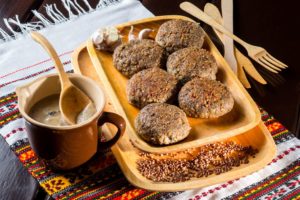 Ingredients: 25 grams of buckwheat, 2 eggs, 1 tablespoon of fat, 1 onion, 30 grams of ground meat, 2 cloves of garlic, 2 tablespoons of chopped greens, salt and pepper for taste, bread crumbs, oil for frying.
Ingredients: 25 grams of buckwheat, 2 eggs, 1 tablespoon of fat, 1 onion, 30 grams of ground meat, 2 cloves of garlic, 2 tablespoons of chopped greens, salt and pepper for taste, bread crumbs, oil for frying.
How to do it: cook loose groats, grind with a meat in a meat grinder, mix with eggs and greens and fried on fat, finely chopped onion, add crushed garlic. Mix. Form small chops, coat them in bread crumbs and fry in oil. Serve with mushroom sauce preferably with forest mushrooms and salad.
Stolniki (cabbage rolls stuffed with mashed potatoes)
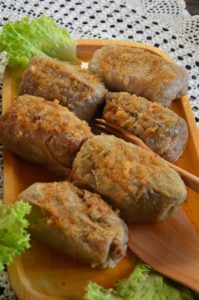 Ingredients: raw potatoes, boiled potatoes, raw eggs, 2 onions, salt, pepper, parboiled cabbage leaves.
Ingredients: raw potatoes, boiled potatoes, raw eggs, 2 onions, salt, pepper, parboiled cabbage leaves.
Ingredients for stuffing: boiled potatoes, ground or crushed white cheese, vitrified onion, salt, pepper, herbs.
How to do it: peel potatoes, grate on a grater and lay out on a strainer so that they drip from the water. We add previously cooked potatoes, fried onion, eggs, salt, pepper and make a homogeneous mass.Then, prepare the stuffing: mix the boiled and mashed potatoes with the ground white cheese, add the fried onion, salt, pepper and herbs. Mix thoroughly. Put a cabbage leaf on your hand, put an even layer of potato mass on it, and put stuffing in the middle. Fold the leaf in half, so that the stuffing is inside the potato mass (folding). Bake the so prepared stolniki (cabbage rolls) in a bread oven until the leaves are brown and the dough blushes. They can be served hot with cream or sauce prepared with fried onion and cream.
Fuczki (sauerkraut pancakes)
 Ingredients: 1.5 kg of sauerkraut, 2 kg of flour, 2 eggs, 1 tablespoon of salt, 1 tablespoon of pepper.
Ingredients: 1.5 kg of sauerkraut, 2 kg of flour, 2 eggs, 1 tablespoon of salt, 1 tablespoon of pepper.
How to do it: cook the cabbage, strain the water, make a flour dough for pancakes, mix with cabbage, add spices. Fry like potato pancakes. They can be served with a bit salty, home-made cream.




